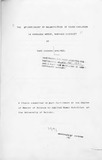| dc.description.abstract | A cross-sectional survey was set up to establish
the prevalence of protein-energy malnutrition and
to identify its probable determinants in Kamnarok
Mosop, Kabartonjo Division in Baringo District. The
survey sought to establish a relationship between
socioeconomic status, water availability,
individual child morbidity experience, time
spent by mothers doing household chores, and
nutritional status of preschool children. The
subjects of the study were children aged between 6-
40 months. Their mothers were the respondents who
provided relevant information about their children
and household amenities.
To determine prevalence of protein-energy
malnutrition of preschool children anthropometric
measurements of each child were obtained. These
measurements included determination of the precise
age, height, and weight of an individual child.
Using weight-for-age as an indicator of prevalence,
the obtained measurements were entered on a Centre
for Disease Control (CDC) programme and compared
~ with the National Centre for Health Science (NCHS)
reference population for each sex. All children
whose weights were less than -2 Standard Deviation
(-2SD) of the standard weight-for-age of the
reference population were considered
undernourished.
About 18.4% of the total study children fell in
this group. Variables which showed associations
with a child's nutritional status were the age and
sex of a child, number of pregnancies of the
mother, childhood morbidity, total household
income, and total time spent by the mother on
household chores. However, no conclusive statements
could be made concerning the determinants of
malnutrition amongst the variables considered.
Though the above variables showed associations with
nutritional status, they had very low correlation
coefficients. There is need for further research
to identify other factors that may have had an
influence on the nutritional status.
Organization of women into groups through which
literacy campaigns and nutrition education can be
chanelled, establishment of income generating
activities to exploit maternal skills and reduction
of household chores to make more time available for
child care recommended for the improvement of
nutritional status. | en |

